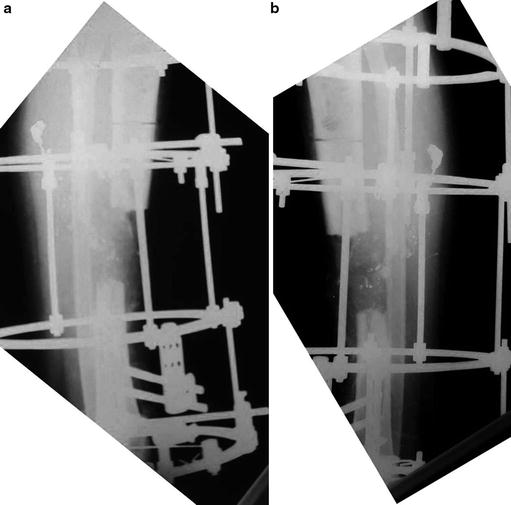Fig. 1
(a) Clinical photo at the time of presentation showed exposed tibial bone through a skin loss on the anteromedial aspect of the middle third of the leg at the site of bullet entry. The fracture was fixed by a monolateral external fixator. (b and c) Radiographs at the time of presentation demonstrate a comminuted fracture of the middle third of tibia. Secondary missiles are dispersed in the soft tissues
3 Preoperative Problem List
Open comminuted fracture middle third of the tibia with extensive soft tissue damage (indicated by the retained secondary missiles and near-distance injury by a high-velocity gunshot )
Delayed presentation
Deep infection
Exposed tibial bone
Soft tissue loss over middle third of leg
4 Treatment Strategy
The goal of surgery was to eradicate infection (by aggressive debridement of all infected and dead tissues), to bridge the bone and soft tissue loss (by distraction histogenesis using Ilizarov external fixator), and to preserve limb function.
5 Basic Principles
The mainstay in the treatment of open, infected, and comminuted fractures of the tibia is the debridement of all devitalized tissues back to healthy bone with early soft tissue coverage. Using the bifocal bone transport, the wound was left open and packed with gauze soaked with povidone iodine, which was changed every few days. With gradual transport, the transported segment descended with its soft tissue cover, and the soft tissue defect was eventually closed by the time of docking.
6 Images During Treatment
Figs. 2, 3, and 4.

Get Clinical Tree app for offline access

Fig. 2
(a and b): Immediate post-operative radiographs after resection of comminuted and devitalized bones (square osteotomy of bone ends) and application of Ilizarov external fixator and proximal tibial Gigli saw osteotomy for bone transport










